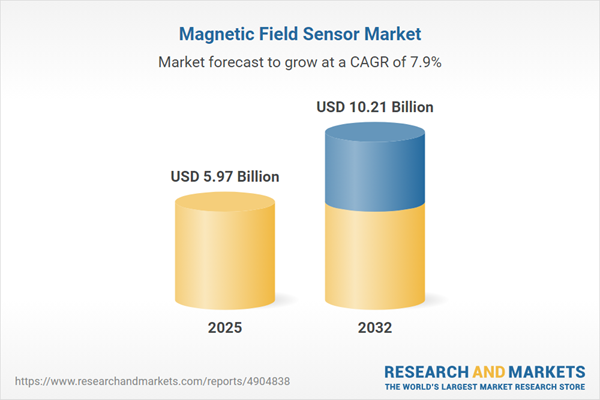Speak directly to the analyst to clarify any post sales queries you may have.
The magnetic field sensor market is experiencing significant momentum, driven by rapid technological advances and growing cross-industry demand for smarter, more precise sensing capabilities. Established and emerging applications are reshaping supply chain strategies and competitive priorities for industry leaders.
Market Snapshot: Growth Trajectory and Market Vitality
In 2024, the magnetic field sensor market reached USD 5.55 billion, expanding to USD 5.97 billion in 2025. Continuing its robust pace, it is forecast to achieve a compound annual growth rate (CAGR) of 7.90%, culminating in USD 10.21 billion by 2032. The market’s expansion is powered by increasing adoption across automotive, industrial automation, and consumer electronics, alongside evolving use cases in healthcare and aerospace sectors.
Scope & Segmentation: Comprehensive Coverage Across Technology, Component, and Regions
- Sensor Types: Fluxgate, Hall effect, induction, magnetoresistive (including anisotropic, giant, tunnel magnetoresistive), and SQUID sensors.
- Component Categories: Communication interfaces, permanent magnets, sensing elements, and signal conditioning and processing circuitry.
- Sensor Category: Analog and digital sensors to meet varied system needs.
- Applications: Current sensing, navigation, positioning, proximity, rotation, and speed detection driving diverse market growth areas.
- End User Industries: Aerospace and defense, automotive, consumer electronics, energy and utilities, healthcare, industrial automation, and robotics.
- Geographic Coverage:
- Americas: United States, Canada, Mexico, Brazil, Argentina, Chile, Colombia, Peru
- Europe, Middle East & Africa: United Kingdom, Germany, France, Russia, Italy, Spain, Netherlands, Sweden, Poland, Switzerland, United Arab Emirates, Saudi Arabia, Qatar, Turkey, Israel, South Africa, Nigeria, Egypt, Kenya
- Asia-Pacific: China, India, Japan, Australia, South Korea, Indonesia, Thailand, Malaysia, Singapore, Taiwan
- Companies Monitored: Includes Aichi Steel Corporation, Allegro MicroSystems, ams-OSRAM AG, Analog Devices, Asahi Kasei, Balluff, BOURNS, Diodes, Ensinger, Hans Turck, Honeywell, ifm electronic, Infineon Technologies, Melexix, MEMSIC, Murata Manufacturing, NXP Semiconductors, Panasonic Holdings, PCE Holding, Pepperl+Fuchs, Robert Bosch, ROHM, Silicon Laboratories, STANDEX, STMicroelectronics, TDK, Texas Instruments, Twinleaf, Zimmer Group.
Key Takeaways for Senior Decision Makers
- Magnetic field sensor technologies are pivotal for enabling accurate motion control, real-time monitoring, and positioning in critical sectors such as electric vehicles and industrial robotics.
- Advances in miniaturization and signal processing have broadened applications, especially for consumer electronics, wearables, and compact medical devices.
- The move toward integrated, energy-efficient designs is accelerating, shaped by demand for seamless IoT, automation, and smart infrastructure implementations.
- Strategic partnerships, acquisitions, and collaborations between sensor manufacturers, foundries, and technology developers are central to maintaining agility and market responsiveness.
- Regional diversification of manufacturing footprints is helping mitigate supply risk and enhance resilience amidst tariff changes and evolving global trade dynamics.
- Continuous innovation in embedded processing and AI-driven analytics is creating new pathways for predictive maintenance and adaptive performance in complex systems.
Tariff Impact: Navigating Global Supply Chain Complexities
The introduction of the United States’ 2025 tariff schedule has created headwinds by increasing costs and prompting manufacturers to re-evaluate supplier relationships. Companies shifted sourcing to tariff-exempt jurisdictions and pursued enhanced local production and automation to maintain competitiveness. These adaptations have diversified supply bases and prompted new regional partnerships while introducing fresh logistical considerations. Leaders that recalibrate sourcing and invest in resilient supply chains will strengthen their position despite these challenges.
Methodology & Data Sources Powering Accurate Forecasts
Findings are grounded in primary interviews with industry executives and technical experts as well as reviews of leading research, patent filings, and company disclosures. Proprietary databases were used to validate trends across sensor types, applications, and regions. Data integrity was verified through expert panels and cross-segment correlation analysis to ensure actionable, high-confidence insights.
Why This Report Matters: Strategic Utility for Market Stakeholders
- Enables strategic planning for product leaders by delivering granular segmentation, technology trends, and actionable intelligence on supply chain and trade impacts.
- Supports executive decisions on investments, M&A, and partnerships by profiling market drivers, competitive dynamics, and future-facing opportunities across key regions.
Conclusion
Robust growth, emerging applications, and complexity in supply chain management are shaping the magnetic field sensor market. Stakeholders equipped with these insights will be empowered to guide innovation, manage risks, and harness evolving opportunities globally.
Additional Product Information:
- Purchase of this report includes 1 year online access with quarterly updates.
- This report can be updated on request. Please contact our Customer Experience team using the Ask a Question widget on our website.
Table of Contents
3. Executive Summary
4. Market Overview
7. Cumulative Impact of Artificial Intelligence 2025
Companies Mentioned
The companies profiled in this Magnetic Field Sensor market report include:- Aichi Steel Corporation
- Allegro MicroSystems, Inc.
- ams-OSRAM AG
- Analog Devices, Inc.
- Asahi Kasei Corporation
- Balluff GmbH
- BOURNS, Inc.
- Diodes Incorporated
- Ensinger GmbH
- Hans Turck GmbH & Co. KG
- Honeywell International Inc.
- ifm electronic GmbH
- Infineon Technologies AG
- Melexix NV
- MEMSIC Inc.
- Murata Manufacturing Co., Ltd
- NXP Semiconductors N.V.
- Panasonic Holdings Corporation
- PCE Holding GmbH
- Pepperl+Fuchs SE
- Robert Bosch GmbH
- ROHM Co., Ltd.
- Silicon Laboratories
- STANDEX INTERNATIONAL CORPORATION
- STMicroelectronics N.V.
- TDK Corporation
- Texas Instruments Incorporated
- Twinleaf LLC
- Zimmer Group
Table Information
| Report Attribute | Details |
|---|---|
| No. of Pages | 189 |
| Published | November 2025 |
| Forecast Period | 2025 - 2032 |
| Estimated Market Value ( USD | $ 5.97 Billion |
| Forecasted Market Value ( USD | $ 10.21 Billion |
| Compound Annual Growth Rate | 7.9% |
| Regions Covered | Global |
| No. of Companies Mentioned | 30 |









